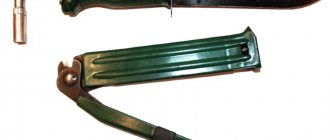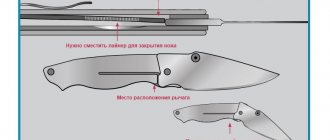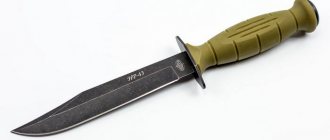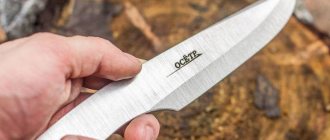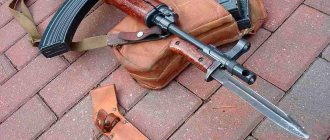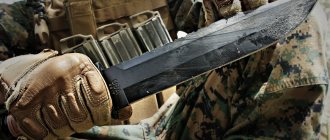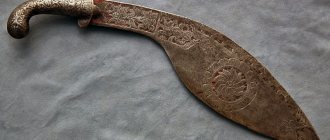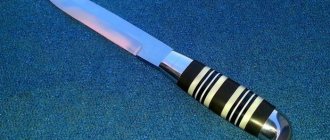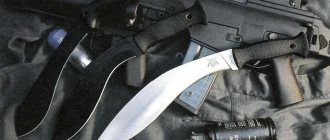A butterfly knife is a tattoo with a hidden meaning. If the image of an ordinary knife speaks of a person’s hot temper, then the “clamshell” indicates the hidden aggression of the bearer. It is known from history that designs of knives and other bladed weapons were applied to the skin by warriors and pirates. The first tattoos with knives were made in black or brown using natural dyes.
With the development of industry, many specialized paints have appeared for body paintings. In most cases, a knife is not simply drawn on the body, and in many cultures such a tattoo tells hidden facts about its owner.
Making tricks more difficult
We throw the knife clockwise, it rotates around the thumb and the “butterfly” opens. This trick is more difficult to perform, but it looks much more impressive.
There is a variation of the previous technique, it is called double rotation. We throw the knife, catch it and throw it again. Or you can further complicate the previous option:
- throw open the knife;
- we intercept it by the safe handle;
- and throw it in again.
In this position the knife usually closes.
A more complex, masterful trick is a throw with a knife turn using two hands:
- take the knife with your left hand;
- we throw it to a height so that it has time to open;
- and we catch it with our right hand.
As you can see, the tricks are not difficult, the main thing is to master the movements of throwing a knife.
To get rid of the fear of getting hurt by a knife blade, you can wrap the edge of the knife with material or tape during your first training sessions.
The butterfly should be thrown to a height that will allow the knife to make the required number of revolutions and after that it will be convenient to intercept it in flight.
These are just some tricks with a butterfly knife. Having mastered them, you can come up with your own and surprise your friends and family with your knife skills.
Russian analogues
Manufacturers of the new generation of butterfly knives are striving to diversify the functions of their products as much as possible, which has led to the emergence of entire tool panels that fit into an all-alloy handle. Such a balisong exists even in Russian history; it was developed by the famous Soviet designer I. Skrylev.
Initially, the butterfly knife, called “Werewolf,” was intended as part of astronauts’ equipment for expeditions and survival in difficult conditions. However, as the first pilot batch is released, the product is being used in various departments of the Ministry of Internal Affairs and special services. The main design changes affected the blade, which received the shape of a scimitar and one-and-a-half sharpening, as well as additional teeth on the top of the blade.
For the manufacture of the blade, stainless steel 65×13 was used, which gave the blade a hardness of up to 57 hrs, with a blade thickness of 4 mm. Increased resistance to fracture, tested under a load of 150 kg, made it possible to use a sharply sharpened butterfly knife even when climbing a vertical surface, as a replacement for climbing equipment.
Spreading the knife around the world
Increased interest in the butterfly knife was revived after the end of World War II. American soldiers brought home many of these devices, which were jokingly called “click-click knives.”
Also, some revived types of fighting arts contributed to the interest in the “winged” knife.
Cinema in its own way contributed to their distribution. In films they were often masterfully wielded:
- Backstreet punks.
- "Bad guys".
This strengthened the view of the image of a knife as an element of a gangster’s device. In any corner of the world in the criminal chronicle you can find a crime committed with the help of such a knife. In many countries, wearing them is punishable by law.
Despite the prejudiced attitude towards this device, it does not lose its popularity. The companies involved in their production supply these products all over the world.
Application in military affairs
Such knives can be used in military affairs, but there are increased requirements for them. One of the military versions of "BENCHMADE" from the "BLUECLASS" series has the following characteristics:
- 32 MORPHO;
- high-grade steel D2 (59-61HRC);
- blade thickness is 2.57 mm;
- blade length is 82.7 mm;
- blade type: Crowned Spear-Point;
- special handle G10 6AL 4V Blue Anodized Titanium;
- handle thickness is only 11.25 mm;
- the clip is made of stainless steel;
- Next Generation Spring Latch;
- weights only 76.54 g.
There is also a Russian manufacturer of such knives. One option that is suitable for military needs is the Skat M Knox. It has an articulated design and is light in weight - only 56 g. Another option, “Scat B,” is perfect for any hiking trip, as it is practical and reliable.
Modern balisongs include not only a blade, but also an additional set of tools that is hidden in the handle. These knives have a slightly different design. Their base includes the union of blades with a steel tool plate.
Butterfly knife in action
The “Werewolf 2” model was presented at the exhibition, which was dedicated to means of survival. Representatives of the Ministry of Internal Affairs, special services and the army immediately became interested in her. After this, this knife was adopted by the special forces of the Ministry of Internal Affairs, the army and the special services. It was used as a survival option.
Interesting! “Werewolf 2” has no analogues abroad, which is why foreign intelligence services also use it. It is ideal for survival in extreme conditions.
The knife is primarily an auxiliary weapon. In modern conditions, it is most often used as a tool for survival.
Types of knives in CS GO
For your convenience, all knives from CS GO are accompanied by sketches of knives, so this article will help you not only find out why the CS GO “butterfly knife” is more interesting than the “bow knife”, but will also answer the frequently asked question: “How to draw a knife from CS GO ?. Each knife drawing is made almost life-size, so it can be used as a stencil for transferring the sketch onto cardboard and, subsequently, plywood or wood. Do you want a real contra knife? There is a diagram, all you have to do is download it, print it out, collect the entire arsenal and color it to your own taste. At least in a box. And pencil masters and sketching virtuosos can simply use pictures!
Components
Dangerous handle
The part of the handle that covers the sharpened part of the blade. If the user holds onto this part when closing the knife, the blade may cause injury to the hand. There is usually a latch on the dangerous handle. (hold on to it when opening the knife so that the blade takes the correct position “away from the user”)
Choyle
The unsharpened part of the blade is just above the kicker; this design makes it easier to sharpen the blade.
Kicker (or kick)
An area on a blade that prevents the sharp edge of the blade from touching the inside of the handle. Sometimes, instead of a kicker, an additional pin is used above the hinges.
Gate valve
Standard locking system that keeps the knife closed. Sometimes magnets are used instead of a valve. Also prevents unintentional opening.
The victorious march of the butterfly around the world
The Filipinos used their original blades until the outbreak of World War II. After its completion, American soldiers brought home many similar knives, which they called “click-click knife.” Since some former warriors could not find a use for themselves in peaceful life, they became bandits. It was these Americans who began to promote balising as a weapon for criminals.
Martial arts, revived after World War II, also contributed to the popularization of the butterfly knife. Hollywood also made its contribution - action heroes of the 1970s and 1980s often famously twirled balisongs in their hands and killed their rivals. This helped to finally cement the knife as a weapon of bandits. “Butterfly” began its victorious march across the planet.
In the second half of the 1980s, balisongs came to the USSR. They immediately became the elite weapon of the punks, displacing the once popular “Finnish guns”. The police immediately outlawed the “winged” elegant knives. In addition to the USSR, these knives were banned in several European countries.
Despite their notoriety, balisongs are still produced by many companies. The most famous of them is Benchmade; their model under the index 42 is very popular in Russia.
How balisongs or butterfly knives came to be
There is no exact version of the origin of the butterfly knife.
According to the Philippine version, this knife appeared in the 8th century and was a family heirloom that was passed down by family members for generations. According to one version, the design of the knife symbolized heaven, earth and water. But archaeological excavations in the area did not allow us to confirm this version.
The butterfly knife also has the name “balisong”, which translates as “broken horn” and “thundering horn”. Scientists have confirmed that the first handles of Philippine knives were made using the horns of various animals.
1905
this year the first documentary mention of balisongs was found
In the same year, the first butterfly knives were made in the Philippine city of Batangas, which are very similar to modern balisongs.
See also the article Tanto combat knives and their description
The document mentions that the first knife was made by the blacksmith Perfect de Leon. The knife was made using precious metals and had a total length of handle and blade of 29 cm.
The European version of the butterfly knife was widely used in the 18th century and combined a ruler designed on the handle and a blade. According to this version, the knife is a direct descendant of a regular folding knife. There is also a version being discussed that the Europeans simply modified a knife of an exotic design that had previously been found in the Philippines.
Butterfly weapon
There is another version according to which the Americans created and brought this knife to the Philippine Islands after the Second World War. At that time, there were clashes between the Japanese and American armies on the islands. After which the butterfly knife began to be used by local residents.
Methods of application
Absolutely all knife models are suitable for everyday needs. They are durable. The only thing that is required is lubrication of the hinges. Many of us are sure that the butterfly knife has only one area of application - criminal. Looking at the “butterflies” in the hands of bandits from television series, we are even more convinced of the exceptional combat qualities of this weapon.
However, the balisong is effective only at the moment of rotation. The knife itself has a thin handle, without a stop. When jabbed, fingers can slide onto the blade, thereby injuring them. A regular knife with a folding and fixed blade will be much more convenient than the advertised “butterfly”.
Balisong is not intended for household use either. Of course, they can cut food, but for a person long-term use of such a knife will result in calluses.
Application in military affairs
Balisong designs are widely used in military affairs. They are distinguished by high-quality steel and precise machining using technological alloys. Blueclass series models:
Law and butterfly knife
In some countries, the wearing, storage, and sale of balisongs is prohibited or limited. In some places you can only wear short bowties; in others they are prohibited altogether. Due to the worsening situation with refugees and terrorists in Europe, the government was forced to tighten laws for balisong manufacturers. To avoid penalties, some companies have moved their production to China and other Asian countries.
In Russia, only models with blades up to 90 mm long are available for sale. If the blade is longer, then you have a bladed weapon, with all the ensuing consequences.
How to choose a butterfly knife
* Before you start choosing a knife, you should understand that balisongs are a rather dangerous type of knife and in a number of countries they are prohibited by law. In particular, in the Russian Federation there is a law “On Weapons”, which states that citizens should not carry butterfly knives with a blade of 90 mm or more, so when buying a knife, be sure to ask the seller for a copy of the certificate, which states that your knife is not a bladed weapon .
So, you have decided to buy yourself a butterfly knife and are wondering about the choice. In order not to make a mistake with the right one, let's go through the points.
Balisongs are quite specific and will not suit everyone. Perhaps you saw a similar knife somewhere and were inspired by the desire, but there is a chance that having found what you want, you will understand that it is not yours and the knife is too complex for you. Therefore, if the idea of buying a “butterfly” has arisen for the first time, we recommend starting with decorative options. Even with a butterfly comb, you can easily learn and even perform various tricks without the fear of getting injured and attracting unnecessary attention.
Having mastered the basic skills of using a balisong on the decorative version, you have two options.
- If you want to learn how to perform various complex tricks, buy a training knife that will be more balanced and convenient for these tasks. If, after several training sessions with a decorative or training option, you have lost the desire to purchase a butterfly knife, we stop at this stage.
- If you think that you don’t need more skills than you already have, or if for some reason training knives don’t appeal to you, immediately buy an original knife.
Structurally, the balisong is quite simple and choosing a good knife is not as difficult as it seems. The most important thing in this type of knife is the handle, this is what makes the knife that very “butterfly”, so the choice is based on its parameters.
1) Handle material.
Usually it is either steel or silumin
- Steel is the most preferred option due to its durability, reliability and strength.
- Silumin is obtained by alloying silicon with aluminum and is significantly inferior in strength to the steel version. Not a particularly good choice for a butterfly, and literally after a few dozen flips the first problems may appear.
2) Soft closing.
Any impacts when closing the butterfly will have a detrimental effect on its design over time. Therefore, it is important that the opening and closing be smooth and soft, so that the halves do not spring when they hit each other. More expensive models use special ball bearings to ensure smooth movement of the elements. In budget options, various types of gaskets are used for these purposes between the handles and the blade.
3) Handle connection type.
During the closing and impact of the handle halves against each other, the knife is subjected to vibrations that affect the quality of the connection. Therefore, the choice of connection type is very important.
- Bolt-on is a common type, very often used in models with a steel handle. The advantage is that a loose bolt can always be tightened, but it is also easy to lose it without tightening it in time.
- Riveted - a less common type. The connection is fixed once at the factory and the user will not be able to tighten or loosen it at any time.
4) Method of making the handle
- Cast - a light, rough-shaped handle, used in knives in the lower and middle price segments.
- Machined - weighty and smooth handle. Used in knives with a relatively high cost.
5) Handle latch.
To secure the knife in balisongs, a latch is usually provided. It connects the two halves of the handle to each other and fixes them as one whole in a closed or open state. In professional “butterflies” it may be absent altogether, due to the need to gain a few seconds of time when opening and closing the knife to the detriment of safety.
How to do it yourself
The butterfly knife has a simple design, which allows you to make this knife yourself at home. To make it you will need some material, tools and a drawing of a bolusong, which can be found on the Internet. Required Tools
- Bulgarian;
- grinding and cutting wheels;
- vice;
- drill;
- set of nozzles for metal carving;
- center punch;
- hammer;
- screws;
- round and flat file;
- sandpaper.
See also the article Types of homemade brass knuckles and their description
Bolsong drawings differ only in design. The mechanism for opening the blade is the same for all.
Butterfly knife drawing
Butterfly knife diagram
Next, you should draw or find and print a sketch of the knife. For the manufacture of a blade, stainless steel with a thickness of 2 to 4 mm is best suited. You can also use an old circular saw blade or an old knife. When making the handle, it is best to use soft metals up to 3 mm.
Manufacturing process
- The first step is to transfer the sketch of the drawing onto a metal blank.
- After marking, secure and process the workpiece, cutting the metal as close as possible to the marking. During the manufacture of the handle, which consists of 2 parts, you will need to make 4 blanks, 2 for each part. Then process the resulting parts using a file and grinder. The width of one plate should not exceed 14 mm.
- After processing, holes should be drilled in the plates. The part of the plate that will be attached to the handle using a hinge should be drilled with drills of various sizes. Then, using hinges, fasten the handle plates. After fastening, you should drill a hole up to 2.5 mm on one part of the plate, and drill two holes on the other part, 3 and 5.5 mm. Two plates form one part of the knife handle. Carry out the same operation with other plates.
- After drilling the plates, the handle should be sanded and riveted. There should be holes of approximately 3 mm in places for riveting. After sanding all the parts, you should take 1 part of the handle and assemble it from two halves, screwing them together with screws into 3 mm holes. Perform the same operation with the other part of the knife.
- Next, you should make a clamp that will securely fix the knife handles in the open position. We drill a 2.5 - 3 mm hole in one prefabricated handle; the latch will be attached to this hole using a rivet. It is best to use a piece of lead for the retainer. You can shape the future retainer using a flat needle file. Lead is a soft metal that can be easily processed. After giving the desired shape, you should drill a hole in the clamp, similar to the hole in the handle, and secure it with a rivet.
- After working with the handle of the future knife, you need to start drilling and sharpening the blade. The work is done using a file and a grinder. Having received the blade of the desired shape, you need to drill 3 holes: 2 - 3 mm each and 1 - up to 5 mm, then grind the metal. The sharp part of the blade should be on the handle with a lock.
- The final stage is assembling all the parts. The first step is to make a rivet in the blade of the blade with a central hole of 5 mm; this will be a latch that helps to extend the blade when opening one part of the knife. Then, by pulling the hinges out of the handle, attach 4 parts to the blade, placing 2 parts on one side of the blade, where the hole is 3 mm, and riveting on both sides. Carry out the same operation with the other side. After assembly, check the knife for opening and closing.
There is still no consensus on what a butterfly knife is needed for. Balisongs cannot be called comfortable in everyday life. A review of the butterfly knife showed that it is used as a decorative or collector's item. Criminals use it to exert psychological pressure on the victim during a robbery. Among young people it has established itself as an element of a subculture.
Is a butterfly knife a bladed weapon?
In the 1990s, there was a legend that a butterfly knife was a bladed weapon. This was due to the fact that almost every self-respecting bandit had such a knife in his pocket and during showdowns it was often used. However, according to the law, balisongs fall under the concept of “edged weapons” only if the length of their blade exceeds 90 mm. Most of these knives do not fall under this article and are therefore not considered edged weapons.
Important! In many countries, knives of this type are completely prohibited. For example, in Germany such a knife cannot be carried, and in Australia a special permit is required for it.
Color solutions
The classic “butterfly” is depicted in dark colors. If the knife has additional decorative details, then the tattoo may be in color. For example, girls wrap a black knife in bright flowers or ribbons, while men prefer a combination of black and red or green. In the fantasy style "Watercolor", where the lines are not clear and blurry, balisong is not depicted.
Styles suitable for this tattoo:
- Blackwork.
- New school
- Old school.
- Sketch style.
- Traditional.
- Trash polka.
- Black and white.
Both the knife blade and the handle can be painted according to the client’s wishes. In addition, edged weapons are depicted with or without shadow, as well as in 3D format.
What is it used for?
Initially, the butterfly knife was used for household needs. Fishermen in the Philippines used it to gut fish and cut ropes during storms. But these days, seeing a butterfly knife in the kitchen is very rare. Of course, you can use it to cut food, but it is inconvenient for constant use.
For a long time, the butterfly knife was associated with the weapons of bandits. Cinema contributed greatly to this. In films, bandits often wore balisongs, demonstrating various tricks that looked very impressive on the screen. Currently, knives with a blade length of less than 90 mm are not considered edged weapons.
The spectacular opening of the knife, its rotation, spinning, twisting, and tossing looks fascinating. This even led to the emergence of a special culture - flipping. Butterfly tricks are popular especially among young people. Currently, special training models are produced with unsharpened blades that will not cause injury.
The butterfly knife is used in military affairs. It performs an auxiliary function, as a universal tool in the fight for survival. Even multifunctional models have been developed for the army and special services, including other tools in addition to the blade. As a survival tool, balisongs are useful for tourists on camping trips.
In general, any model of this knife is suitable for everyday needs. They feature a durable and reliable design that will last for a long time.
Who is suitable for drawing and who is not?
A butterfly knife is a tattoo that is not suitable for everyone. Edged weapons on the body look harmonious for people involved in various types of martial arts. In addition, chefs and other representatives of professions where this tool is used draw knives on their bodies.
Masters do not recommend stabbing teenagers with knives, because the picture carries a certain symbolism that does not fit with the psychology of a growing organism. Edged weapons look ugly on fragile girls.
A butterfly knife, like any other tattoo, once it gets on a person’s skin, begins to affect the owner. A previously soft and compliant guy will more often show aggression or intolerance, and the girl will knock out the offender with a harsh word.
Story
The origin of balisongs is unclear. Oral evidence states that such knives were first created in the Philippines around 800 AD. However, there are no documents or archaeological evidence to support this evidence. Mass production of blalisongs in the Philippines was only witnessed in the early 1900s. Another claim is that the balisong was an original adaptation of a French measuring instrument called the "pied du roi" ("king's foot"), invented between the 1500s and the late 1700s. However, it is unknown how such specimens appeared in the Philippines. There are theories that this instrument could have been imported by sailors from the Spanish Empire, which was then an ally of France.
Regardless of its origins, the modern balisong was refined in the Philippines, where it became much larger and was used primarily as a weapon rather than as a measuring instrument. Rapid opening ("flipping") techniques have also been developed in the Philippines. Unlike the balisong, the French pied du roi was primarily a folding ruler, and the knife blade was included as an additional tool in some designs. “Pied du roi” were bulky, difficult to open, and in general, these rulers could hardly be used for self-defense. Moreover, to facilitate measurements, specialized metal tips were built into the design of the measuring instrument at the end of the handle. There were also designs very similar to balisongs. They were produced in England at the end of the 19th century, presumably based on the same “pied du roi”. However, like their predecessors, these English counterparts were primarily utilitarian instruments.
Bayonet knife.
Quite a common type of knife. The bayonet has a hole closer to the tip; it serves for attachment to the barrel of a weapon. A huge number of skins have been released for the bayonet mount, as well as a sufficient number of options on how to draw all the knives from CS GO. As usual, we have our own offer!
Trick "Ventilation"
An element from the protozoa section. To perform it correctly and safely, you must follow the instructions:
- The knife is taken by the safe part.
- The blade is lowered down, and the fingers are folded into a tube so that the thumb and forefinger lightly hold the blade. The handle should move freely between the unused fingers and the hand.
- The knife can be rotated using any comfortable method.
- To return to the starting position, you need to catch the moment when the handle is located above the hand and slow down its movement as much as possible. The balisong should close on its own.
Performing the “Ventilation” trick with a butterfly knife.
Tattoo placement options
Butterfly knife tattoos are placed on different parts of the body. Its meaning also depends on the location of the picture:
| Where is | What does it mean |
| On the index finger | Decisiveness and quick reaction |
| On the middle finger | The superiority of the owner over society |
| On the neck (passes through the Adam's apple) | Extraordinary personality |
| On the wrist | Prepare for a surprise attack |
| On the shoulder | Courage and willingness to stand up for yourself |
| On the stomach | Secretive character and presence of “skeletons in the closet” |
| On the foot | Vigilance and control of the situation |
In addition, men put an image of a knife on their back or head.
The presence of a balisong under the chest of representatives of the stronger sex indicates that they may often participate in street fights or belong to gangs.
